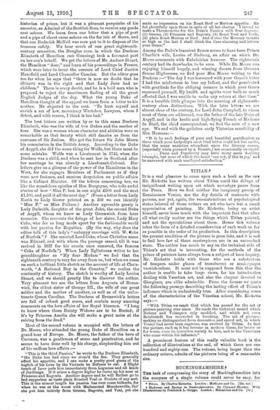BUCKI.NGHAMSHIRE4 Tim task of compressing the story of Buckinghamshire into
the compass of a single volume could never be easy, for
• Titian. By Charles Ricketts. London Methuen and Co. [15s. net.] t Mighicags and Brings in Buckinghamshire. By Clement Shorter. With Illustrations by Frederick L. Griggs. London: Me...maim and Co. On)
though, as Mr. Shorter reminds us, it is the thirty-third in size of the forty English counties, it has through all English history been a county of famous men and deeds. Whether Magna Charts was actually signed on the island bearing that name, which is now part of Buckinghamshire, or whether John put his seal to the Charter on Runemede in Surrey, may be doubtful ; but other associations with the progress of English thought and English freedom are not disputed. It was in the church of Great Kimble that John Hampden refused to pay ship-money. At Chenies lived the Russell whose death on the scaffold showed Englishmen what could still be expected from a Stuart dynasty. Burke is buried in Beaconsfield Church. Part at least of Paradise Lost was written in Milton's cottage at Chalfont St. Giles ; Cowper's home is still to be seen at Olney ; Waller is buried in the churchyard near Burke ; and it was in the churchyard at Stoke Poges, or so many are ready to claim, that Gray wrote his elegy ; his " Ode " (which in Mr. Shorter's book is quaintly misprinted) belongs to Eton. Marlow, besides Eton, claims Shelley, and at Marlow Mrs. Shelley wrote Frankenstein; Shelley had first come to the little town to visit Peacock. Of other famous names, the Disraelis, father and son, bad their homes at Bradenham and Hughenden ; Penn's grave, visited by countless American tourists, is at Jordans ; Wilkes's residence was the Prebendal, Aylesbury; and the rector of Ludgershall from 1368 to 1390 was John Wyclif.
These and others make a long and illustrious list, and in dealing with them, and in deciding the space which each should occupy, Mr. Shorter has done very well. If in his chronicles of lesser men and women he is a little too fond of dates and genealogies, he shows a better judgment in dealing with the broad facts of the larger lives which come into his story. The result is an interesting book about Buckingham- shire men and women. But has not Mr. Shorter forgotten the claims of his title ? There is hardly a word in the book about highways and byways, except so far as you may measure distances on them in a motor-car. We are left with the impression that the whole county was travelled over in a motor-car, and the result is that of the quieter, slower pro- cesses of the countryside, the life of the cottages and of the farms, the air of the hills and woods, the crops, trees, birds, and flowers, we are told almost nothing. Mr. Shorter anticipates this criticism. "There are varied things that attract to a county," he writes. "Fishing, shooting, hunting, for example, are three of many. I am interested in none of these. Buckinghamshire attracts me wholly on the human side." Well, every writer is entitled to his choice. But even on the human side of the life of the county, has all been said that should be said when in "essentially an agricultural county," as Mr. Shorter describes Buckinghamshire, "the social aspect of agriculture may be summed up" in four lines ? The county industry of chair-making, again, deserves more than a dozen- line paragraph. Perhaps the influence of the motor-car is discernible in the fact that we may search Mr. Shorter's index in vain for mention of the oldest highways, Watling Street, Akeman Street, and the Icknield Way, all of which run through the county. But the motor-car pants most audibly when it will not wait in the villages. Generally it rushes straight to the church door, and we get a glimpse or not as it may be of a Norman fount or a quaint epitaph. But it does not always wait long enough even for that. It seems to have drawn up at Langley Church, for instance, but we only get a bare mention of the library in the church, and not a word of the superb Jacobean woodwork, or of the famous Keder- ruinster pew, with the eyes on its panelled ceiling. There is surely a "human side" to that strange painting.







































 Previous page
Previous page